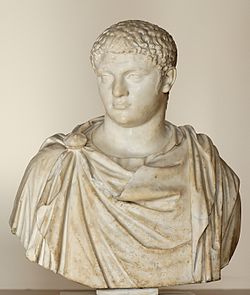|
Geta - Roman Caesar: 198-209 A.D. -
Bronze 16mm (3.1 grams) of the Provincial city of Nicomedia in Bithynia with
Necorus honor
Π CEΠTI ΓETAC, draped bust of Geta right.
NEΩKEΩN within fiery altar, ΔIYC above, NIKOMHΔEΩN across fields and in exergue.
Neocorus was a Greek title which designated the individual
who had charge of the interior of a temple and looked out for the temple's
needs. In Roman times, provincial Greek cities often styled themselves as the
neocori of the imperial cult. This was an obvious form of flattery, which
insinuated the godliness of the emperor and indicated the city's devotion and
loyalty. The neocorate of a city was a great and coveted honor, and not one
which was presumed arbitrarily. The emperor allowed the bestowing of this right
only to cities which had earned the status. Consequently, cities were eager to
announce this consideration and usually did so on their coinage. The
proclamation of a neocorate on coins was often accompanied by a depiction of the
temple.
Originally, it was imperial policy that only one neocorate would be allowed in a
city. This rule was later relaxed, and several cities were allowed two or more
neocorates. The subsequent awards were depicted on coins by showing two or three
temples along with an appropriate inscription. The first neocorate of a city was
usually mentioned in the inscription simply as NEΩKOPΩN. The second appeared as
B NEΩKOPΩN, the third as F NEΩKOPΩN (e.g. Pergamum).
The approval of neocorate was usually accompanied by games and festivals. The
coins struck for these events often displayed a combination of neocorate and
agonistic imagery. Like the number of temples depicted, there also seems to be a
correlation between the imagery and the award on some of the "games" issues.
Although this may be coincidental, coins bearing the single NEOKOPOC often have
a singular agonistic crown or urn, which is in the center field between the
temples. Those indicating a second or subsequent neocorate have two or more
crowns.
The iconography of neocorate and agonistic references is very complex and not
fully understood by most numismatists. It is, however, a wonderful area for
study, research and discovery. You may learn more about the interrelationships
between these aspects of religion, civic administration and public events, and
then we will undoubtedly be able to unravel some of the underlying symbology.
You are bidding on the exact item pictured,
provided with a Certificate of Authenticity and Lifetime Guarantee of
Authenticity.
 Publius Septimius Geta (March
7, 189–December
26, 211),
was a
Roman Emperor co-ruling with his father
Septimius Severus and his older brother
Caracalla
from 209 to his death. Publius Septimius Geta (March
7, 189–December
26, 211),
was a
Roman Emperor co-ruling with his father
Septimius Severus and his older brother
Caracalla
from 209 to his death.
Early
life
Geta was the younger son of Septimius Severus by his second wife
Julia
Domna. Geta was born in
Rome, at a time
when his father was only a provincial governor at the service of emperor
Commodus.
Geta was always in a place secondary to his older brother Lucius, the heir
known as Caracalla. Perhaps due to this, the relations between the two were
difficult from their early years. Conflicts were constant and often required the
mediation of their mother. To appease his youngest son, Septimius Severus gave
Geta the title of Augustus in 209. During the campaign against the
Britons of the early 3rd century, the imperial propaganda publicized a happy
family that shared the responsibilities of rule. Caracalla was his father's
second in command, Julia Domna the trusted counsellor and Geta had
administrative and bureaucratic duties. Truth was that the rivalry and antipathy
between the brothers was far from being improved.
Joint
Emperor
When Septimius Severus died in
Eboracum in the
beginning of 211, Caracalla and Geta were proclaimed joint emperors and returned
to Rome.
Regardless, the shared throne was not a success: the brothers argued about
every decision, from law to political appointments. Later sources speculate
about the desire of the two of splitting the empire in two halves. By the end of
the year, the situation was unbearable. Caracalla tried to murder Geta during
the festival of
Saturnalia
without success. Later in December he arranged a meeting with his brother in his
mother's apartments, and had him murdered in her arms by
centurions.
Following Geta's assassination, Caracalla
damned his memoryy and ordered his name to be removed from all inscriptions.
The now sole emperor also took the opportunity to get rid of his political
enemies, on the grounds of conspiracy with the deceased.
Cassius
Dio
[1]
stated that around 20,000 persons of both sexes were killed and/or proscribed
during this time.
|